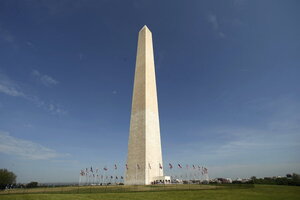Washington Monument is not shrinking, except for this one bit
On Monday, officials with the National Geodetic Survey announced that the Washington Monument is now 554 feet, 7-11/32 inches tall. So the Father of Our Country, or at least his memory in stone, isn’t standing as tall as he used to.

Free from its scaffolding, the Washington Monument is re-opened to the public, in this file photo taken May 12, 2014.
Kevin Lamarque/Reuters/File
The official height of the Washington Monument is now 10 inches shorter than it used to be.
Since its completion in 1884, generations of tour guides have told visitors that the famous obelisk is 555 feet, 5-1/8 inches tall. That used to make it the tallest structure in the world. It’s still the tallest all-stone structure in the world, and the tallest thing in Washington, D.C.
But on Monday, officials with the National Geodetic Survey announced that as far as they’re concerned, the Washington Monument is now 554 feet, 7-11/32 inches tall. So the Father of Our Country, or at least his memory in stone, isn’t standing as tall as he used to.
Shrinkage? After all, lots of us get shorter as the years roll by. But in this case, that’s not entirely what is happening, according to officials.
Rather, the starting point for the (virtual) measuring tape has changed. The original 1884 measurement began at four brass markers at the monument’s base. They are still there, but are now underground. The most likely explanation for this is that renovations around the famous tourist destination have raised the ground level at the site.
Today, the Council of Tall Buildings and Urban Habitat, the organization that rules on such matters, says that a building’s height is measured from the lowest open-air pedestrian entrance to the building. Using that standard on the Washington Monument knocked nine inches off its previously announced height.
“The building didn’t change height because of anything; it is just where you start from,” said Dru Smith, chief geodesist of the National Geodetic Survey.
Except ... the arithmetically gifted among you will realize that this leaves about one inch of lower altitude unaccounted for. The best guess for that is battering of the Washington Monument’s aluminum tip. It’s been struck by lightning repeatedly over the years.
In fact, Mother Nature has been tough on the monument over the years. Lightning has previously blown bits of stone at the top out of alignment. In an 1885 report, an Army Corps of Engineers officer noted that a bolt had struck the monument that June and cracked the top just below the aluminum cap.
This even “caused considerable concern," wrote metallurgist George Binczewski in a (charmingly unusual) history of the Washington Monument’s aluminum summit. Extra lightning rods were bolted to the structure.
Perhaps you knew this, but it turns out that in aluminum circles, that battered tip is famous in its own right. In 1934, the chief metallurgist for the Aluminum Company of America declared it “the crown jewel of the aluminum industry.”
Back in 1884, the Army engineer in charge of finishing the monument, Thomas Lincoln Casey, decided he needed a lightning rod at the tip. He opted for aluminum over copper or bronze, and the rest is metallurgical history.
In 1984, the Frishmuth foundry, which made the original casting, produced a replica of the cap. It was displayed at Tiffany’s in New York City.
“A high honor was bestowed on aluminum when it was chosen for the metal point of the national monument that is instantly recognized around the world as a symbol of the United States,” wrote Mr. Binczewski.

